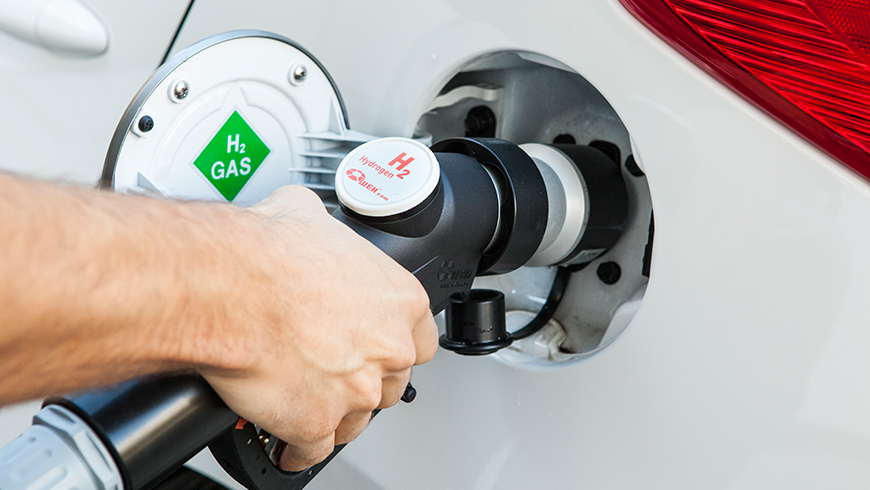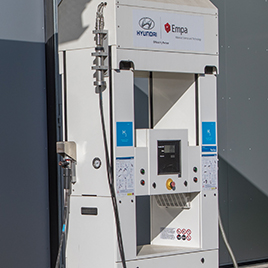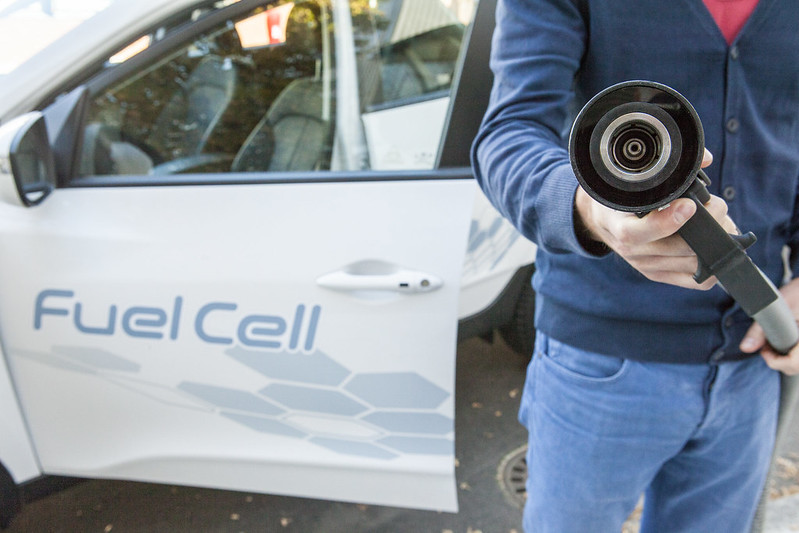“move” with 700-bar hydrogen station
Rapidly fueled for a long range journey

The mobility demonstrator “move” backed by the Federal Office of Energy (SFOE), Coop and various other industrial partners on the Empa campus in Dübendorf has been in operation since November 2015. Besides an electricity filling station, it also offers pumps with natural/biogas (CNG for “compressed natural gas”) and a mixture of natural/biogas and hydrogen (HCNG). Until now, pure hydrogen had been available with a filling pressure of 350 bars, which is primarily suitable for refueling utility vehicles with large tanks. By installing the 700-bar pumps for hydrogen, Empa is now responding to the needs of fuel-cell cars: compact tanks, the longest possible range and rapid refueling. Hydrogen-powered cars can now be refueled in only two to three minutes and have a range of up to 600 kilometers on a full tank, which suddenly gives fuel-cell vehicles a competitive edge over conventional gasoline or diesel vehicles in terms of refueling comfort.
To make rapid refueling possible, the compressed hydrogen is pre-cooled to -40°C. This is necessary to prevent the temperature in the tank from rising too much due to the compression heat generated during the refueling process. The vehicle “communicates” with the pump nozzle via an intelligent infrared interface during refueling and provides data on the temperature and filling status, for instance. Empa’s new hydrogen station is closely linked to the first fully public hydrogen station in Hunzenschwil, which Coop Mineraloel AG is set to open in cooperation with H2 Energy AG at the beginning of November.
The key to success: the ability to store renewable energy
Hydrogen is crucial for the integration of renewable energy, which doesn’t always accumulate when needed. Therefore, it needs to be stored temporarily. Today, small-scale battery storage devices and large-scale pump storage power stations on the bottom and top power supply levels respectively are available for this purpose. However, there is an increasing need for technologies that lie somewhere in-between in terms of capacity and performance, and are connected to a middle power supply level. This includes power-to-gas plants, for instance, which can convert renewable electricity into fuel, such as hydrogen or methane, whenever it can’t be used economically on the energy market, and therefore replace gasoline and diesel.
This especially makes sense for “frequent drivers”: around 20 percent of all vehicles in Switzerland clock up more than 20,000 kilometers a year and are responsible for almost half of all the kilometers driven. In order to convert such vehicles from fossil to renewable energy, large ranges are therefore necessary, which purely electrically powered vehicles with batteries are unlikely to provide anytime soon. Hydrogen vehicles, however, are also suitable for long trips. Empa is studying various types of use for hydrogen at the recently expanded filling station: directly for machines, utility vehicles and passenger cars with fuel cells, and as an admixture with natural/biogas for gas vehicles.
"move" is one of Empa's demonstration platforms backed by numerous partners from research, indus-try and the public sector. Empa’s main partners here are the ETH Board, the Swiss Federal Office of Energy (SFOE), the City of Dübendorf, Glattwerk AG and the companies AtlasCopco, H2 Energy and Hyundai. These are joined by a series of academic and industrial partners who are involved in individual projects within the scope of the demonstrator.
| Audio |

Radio programme on SRF1 of 28 June 2019 in German. Künftig sollen mehr Fahrzeuge mit Wasserstoff als Treibstoff fahren. Die Empa betreibt eine der aktuell zwei Wasserstofftankstellen in der Schweiz. Empa-Forscher Urs Cabalzar spricht über Vorteile und Herausforderungen des Antriebs mit Wasserstoff. www.srf.ch/sendungen/rendez-vous/
-
Share


